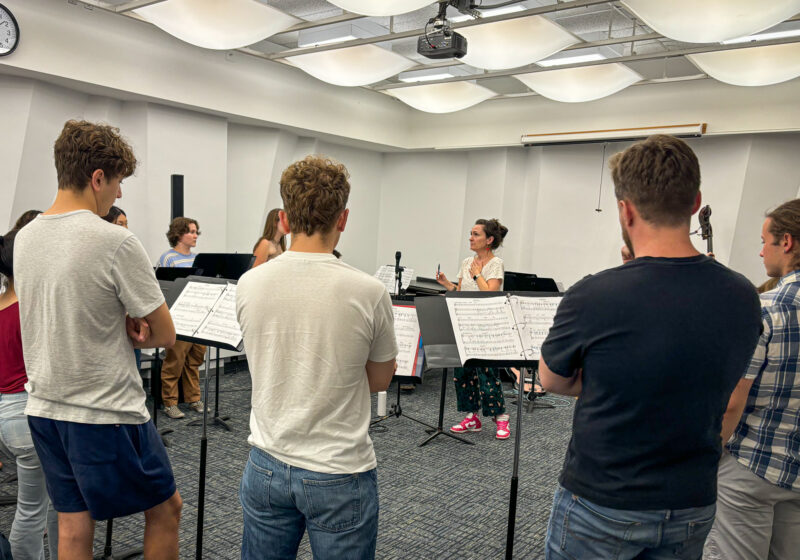The Eastman Opera Theatre presented Francis Poulenc’s opera “Dialogue of the Carmelites” on Feb. 11 through 14 in Christ Episcopal Church. The Stage director was Steven Daigle and the music director was Benton Hess. Hess also performed the entire opera on the piano, as the space limitations didn’t allow an orchestra. Despite the lack of space, scenery constructors Ray Suarez and Matt Schedit did a magnificent job adapting the front of the church to an opera scene. Each component of the three part set was designed to open in every direction and thus allow an easy representation of multiple locations. Poulenc’s opera is based on the drama by Georges Bernanos. It tells the real story of the Carmelite community from Campigne. The fifteen nuns led by Sister Teresa of St. Augustine were executed on the guillotine in mid-July, 1794, during the terror following the French revolution. They were venerated by Pope Leo XIII in 1902, the first step towards canonization. Later, in 1906, Pope Pius X beatified them. The cast from the of Feb. 12 show included two exceptional alto singers, Alta M. Boover as the old Mother Superior and Margaret Gawrysiak as Mother Marie. They had very individualistic and immediately recognizable timbres and singing styles. In her first appearance as Mother Superior in Act I, Boover sang a rich low f sharp, achievable only by real alto singers rather then mezzo-sopranos. At the end of Act II she was incredibly good in the role of the dying Mother Superior who questions her belief in God and pities the young Sister Blanche. Boover’s acting was extraordinarily moving and the death scene itself brought tears to the eyes of the audience. She built up the tension in her voice gradually to the line of “When had [God] cared about me?” At this moment she managed to balance pitch and screaming voice very successfully in order to convey the despair in her heroine without giving up on the actual notes. Even though Blanche de la Force is the assumed main character of the opera, Mother Marie gradually becomes the predominant figure in the plot and the music. This impression was reinforced by the thin and soft voice of Sarah Minchler, who performed Blanche’s role. The duets between Minchler and Gawrysiak overly exposed the strong operatic nature of Gawrysiak’s alto against the chamber nature of Minchler’s soprano. Production stage manager Lindsay W. Baker made an excellent use of the aisle in Christ Church. It became a part of the stage just as much as the stage itself. At the very end of Act III, the nuns walked slowly to the back of the back of the church and fell one by one as though being executed. Lighting designer Nic Mineton and his team provided the sound effect and the enormous shadow of the guillotine projected on the wall. The result was unusually realistic and persuasive. The most enthusiastic applause and cheering at the end of the Thursday night performance of the “Dialogue of the Carmelites” was rightfully reserved for altos Boover and Gawrysiak, as well as for Hess. His piano accompaniment exemplified tasteful interpretation and an in-depth knowledge of the orchestral score. The upcoming performances of the Eastman Opera Theatre include Carlisle Floyd’s “Susannah” on April 1 through 4 and opera scenes on April 15 and 16.Fol can be reached at afol@campustimes.org.
Center for Community Engagement
Fighting against poverty in Rochester with the Urban Fellows Program
Urban Fellows, an annual program hosted by the Center for Community Engagement (CCE) and funded by Americorp, gives undergraduate students the opportunity to work with local nonprofits over the summer — and get paid for it.
concoction
I got tired of eating Pit food, so I made my own concoction
I’ve long since started getting food from off-campus (E Suki and Taichi my beloved), but recently I’ve considered giving campus food another try — this time, on my own terms.
Eastman
New vocal jazz program at Eastman
Not a trace of the thunderous applause from just a moment earlier lingers in the air; instead, the crowd is hushed, breath caught in their chests for fear of breaking the spell.





